Stelmuzes church and bell tower (Stelmuzes Sv. Kryziaus baznycia) description and photos - Lithuania: Zarasai
Rating: 9,4/10 (786 votes) 
Stelmuzes church and bell tower (Stelmuzes Sv. Kryziaus baznycia) description and photos - Lithuania: Zarasai. Detailed information about the attraction. Description, photographs and a map showing the nearest significant objects. The name in English is Stelmuzes Sv. Kryziaus baznycia. Photo and descriptionOne of the most ancient ensembles of ethnographic construction, which appeared in the feudal period in Lithuania and carries the spiritual and material heritage of the work of our ancestors, are the Stelmuzhsky church and the bell tower. These exhibits are the monuments of sacred wooden architecture. The bell tower and the church, preserved on the territory of the Stelmuzh estate since the 17th century, are considered architectural monuments of republican significance. The Church of the Holy Cross was built in 1650. At that time, it belonged to the branch of the Lithuanian Ilukste church and belonged to the Kelvists. Earlier it was believed that the Stelmuzhskaya church was built by the owners of the estate after the fugitive serf was caught. When asked why he ran away, he replied, fearing his masters, that he fled not from the cruel treatment of his masters, but from the fact that there is no way to go to church and repent of his sins. But in fact, the Church of the Holy Cross (or the Church of the Lord's Cross) was built in 1650 by order of the Volkerzamb nobles. It was erected by Latvian craftsmen only with a chisel and an ax, and nails were used only to make the doors of the church. This is one of those churches in Lithuania, where wooden items of great artistic value have been preserved. The church is located on a high hill, densely overgrown with numerous trees, not far from the former estate. As for the appearance of the church, it is distinguished by rather heavy proportions, and a gable roof, made in the form of a rafter structure, prevails in its entire composition. The interior composition of the church is decorated with two amazing masterpieces of art - the pulpit and the altar. This kind of creativity finds a place in the churches of Latvia. A considerable number of analogues suggests that a similar interior of the church appeared in the late 17th - early 18th centuries. The uniquely executed wood carvings date from the late Renaissance period. The church has a museum of church art, which anyone can visit. In 1713, the building of the church was reconstructed at the expense of the owner of the Stelmuzh estate, Baron Volkersamba, who was born in Germany. Since 1808, the church began to belong to Catholics. By the beginning of the 18th century, the architectural style of folk forms, including churches, was especially influenced by the Baroque style, which is largely manifested in the arrangement of interiors. It is believed that in 1973 the interior of the sacral building was decorated with an altar with sculptures and a pulpit, which is very similar to the pulpits of Lutheran Latvian temples. The altar, which has its own sculptures and pulpit, is a republican monument. The Church of the Holy Cross is a wooden building made in the style of classicism. There is a crucifix inside the church on the right side, at the foot of which there was a relief work that was there until 1939. The work is called "The Last Meal". Later this work was transferred to the Franciscan Church in Vilnius; since 1949, the work has been in the Kaunas Historical and Ethnographic Museum. Inside the church you can find a large number of valuable Baroque decorations, for example, bas-reliefs, sculptures, high-reliefs, openwork ornamentation and twisted columns. These wooden products are in the only form and copy in Lithuania, which is why they are of great value in modern times. Most likely, some of the sculptures were made back in 1713 by masters from Ventspils. Not far from the church, in the western part of the courtyard, there is also a 17th century wooden bell tower, which is an important part of the sacred ensemble. The bell tower is very functional, expressive in its proportions and silhouette, but distinguished by its simplicity of forms. The bells were cast in 1613. This ensemble stands out especially clearly among similar works in Lithuania, because with its originality it attracts the special attention of many art critics.         We also recommend reading Kaunas castle (Kauno pilis) description and photos - Lithuania: Kaunas Topic: Stelmuzes church and bell tower (Stelmuzes Sv. Kryziaus baznycia) description and photos - Lithuania: Zarasai. |




